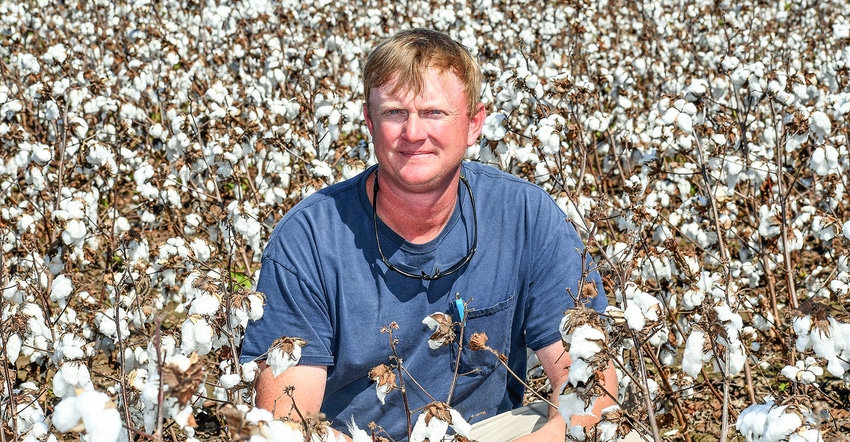
Losing an important piece of weed management technology like dicamba is never convenient but losing it in the middle of the growing season is tough for those with pigweeds in their fields.
Russ Ratcliff, a third-generation farmer in Tensas Parish in Louisiana, said the pigweeds were bad this year without the full use of dicamba throughout the growing season.
Dicamba versus pigweeds
After the June 2020 ruling by the Ninth Circuit Court of Appeals, dicamba products' registrations were vacated. This included Xtendimax, Engenia, and FeXapan.
"Losing dicamba midway through the growing season was about one of the biggest headaches we've had this year," Ratcliff said. "Pigweed is our main weed problem like it is in a lot of places in the Delta, so losing that technology in the middle of a growing season was hard.
"We tried chopping out as many weeds as we could in hotspots we had in the fields. There were too many to get them all. Because all our crops, except for rice, are dicamba-tolerant, dicamba was our main tool for weeds after the crop started growing since it penetrates the canopy better. We also use Liberty, but it is more of a contact weed killer while dicamba helps control it throughout the season."
Most farmers book their seed in the fall or winter.
"December and January are the months we buy the dicamba, Liberty, or Roundup Ready traits," he said. "We plan what product we're going to put where and when, so by having to discontinue using dicamba in the middle of the season, it was like taking one of your most useful tools out of your toolbox and throwing it away."
Hurricanes during harvest
On the 3,000-acre farm, around 1,000 acres are planted in rice, 1,500-acres are planted in cotton, and the last 500-acres are planted in soybean and corn.
"Primarily, we grow cotton and rice, and we'll follow up with soybean and corn for our rotational practice," Ratcliff said. "Each harvest season throws a new curveball. This one was the hurricanes."
Louisiana experienced several hurricane warnings as well as hurricanes to make landfall. The two hurricanes to cause the most damage, Hurricane Laura and Hurricane Delta, were a little over a month apart from one another.
"We've had wet falls to deal with in the past, but this year it was mostly from hurricanes," he said. "You want sunshine and blue skies in August, September, and October. When the sun is shining, you try to make the most of it and do what you can in that little timeframe."
While the hurricanes did flatten some crops, other crops turned out well despite the weather.
"Corn was the first crop we harvested," Ratcliff said. "At first, the harvest was going smoothly until the first hurricane came through about halfway through the corn harvest, and it blew around 200-acres of our corn down flat. It was an absolute nightmare trying to pick up.
"What rice we still had in the field at the time, the hurricane flattened also, which adds a lot of time and costs to your harvest. You don't have a lot of time this time of year to be stuck harvesting down crops.
"We had to rent another combine to take care of the downed rice. It slowed things down considerably, which pushed the cotton harvest back another 10 days."
Luckily, most of Ratcliff's yields have been good despite the difficult harvest, and he said his cotton crop is one of the best ones he has had in a few years.
"During Hurricane Laura, the unharvested soybeans received a little bit of damage, but after the ground dried back out, it was what we hoped it would be overall," he said. "We had a good soybean crop. We were in the 50 to 70-bushel range, which is what we hoped for. The corn yield was around 180 to 190, which is a decent average for us.
"The rice yield was good. We had some fields around the 160-bushel range, and then we had some in the 190-bushel range. Even though the rice was blown down, we were still able to recover most of it. There were some milling issues on the blown down rice because it was on the ground so long, but it wasn't too detrimental."
By about mid-October, only 500 acres out of 1,450 in cotton was left in the field when Hurricane Delta hit.
"The cotton yield was excellent up until the storm," Ratcliff said. "The wind from the storm knocked some bolls on the ground, but we still have one of the best cotton crops in several years."
Waterfowl habitat
A few conservation practices incorporated on the farm include planting cover crops, leaving the ditch banks grassy to prevent runoff and soil erosion, as well as flooding rice fields in the winter for waterfowl.
"Through the NRCS, we've created a waterfowl habitat," Ratcliff said. "We'll flood our culverts and some fields through February, and then start to drain them. The waters will fill up with mallards, pintails, and geese. The NRCS has done several counts and studies, and we have had several thousand ducks at one point. It's a great program to take part in."
Read more about:
DicambaAbout the Author(s)
You May Also Like




